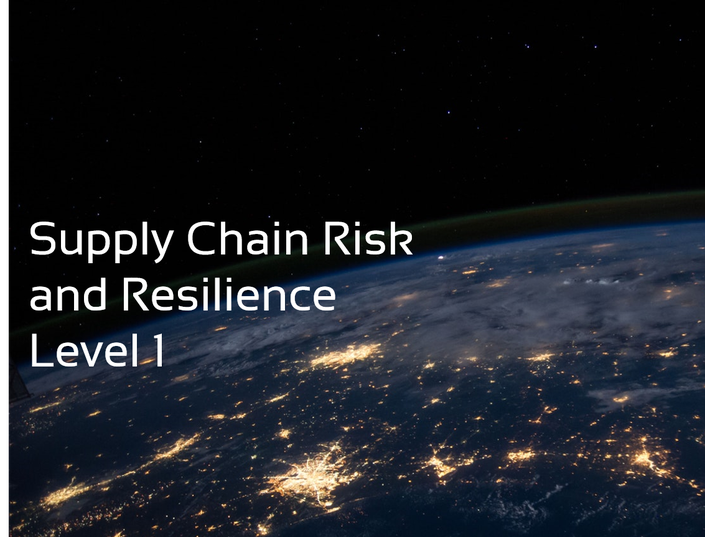
Supply Chain Risk and Resilience Level 1
Connecting supply chain fundamentals with the increasing trend of global volatility, uncertainty, complexity and risk.
Watch Promo
Introduction
Surveys and studies have concluded that, for a variety of reasons, supply chain risk is increasing globally and that supply chain resilience is increasingly a competitive differentiator. The financial impact of supply chain disruptions can be devastating and are often not understood until it is too late. Supply chain strategies driven primarily by cost management and delivery improvements are no longer comprehensive enough to ensure competitive success. Unfortunately, showing a hard ROI for risk management initiatives is a difficult sell.
This new course provides knowledge and tools to guide you through understanding the choices available to your organization to manage supply chain risk and enhance the resiliency required for long term sustainability and profitability. Structured in three levels, Level 1 will review Supply Chain Management fundamentals, industry trends, the impact of uncertainty, complexity, and risk and the identification of supply chain risks.
In Levels 2 and 3, toolsets will be developed and case studies offered that delve into the impact of risk on various aspects of your organization.
Supply chain risk is increasing globally as supply chains expand to all corners of the earth. Supply chain resilience is increasingly a competitive differentiator to gain and keep business.
It is no longer sufficient for supply chain strategies to be primarily driven by cost management and delivery improvements. As a learner, upon completion of the three levels, you will acquire knowledge and insight that enables you to identify, assess, mitigate and manage supply chain risks. This will culminate in earning the Supply Chain Risk and Resiliency Certificate.
Scope of this Course
This course is to provide a level of appreciation to the learner regarding the elements of basic supply chain management (SCM), an evolving field which seeks to integrate the functions of an organization. While SCM has evolved in improving organizations’ efficiency and profitability by applying technology, vulnerabilities have been exposed through globalization. The course seeks to position the continued maturity of SCM in a more comprehensive approach including supply chain risk and resilience.
There will be multiple themes in all three levels such as the financial impact of supply chain disruptions. These can be devastating but are often not understood until it is too late. Disruptions caused by natural disasters or malicious actions or poor management have an ever greater impact on supply chains. The supply chain profession, which integrates the many functions that organizations need to operate, is an evolving discipline impacted by technology and greater risk. Understanding these components is a must for the novice in this field as well as the experienced manager. The course utilizes the principles of Supply Chain Risk Management, authored by Greg Schlegel and Robert Trent.
Skills you will learn
Gain an appreciation for basic elements of Supply Chain Management
Understand the reasons for good supply chain risk and resiliency best practices
Learn of the financial implications of supply chain disruptions
Identify supply chain trends and their impact on profitability and resiliency
Gain an understanding of the impact of global volatility on supply chain operational performance
Increase comprehension of the importance of supply chain cyber security
Who Should Attend
Level 1 is intended to set the foundation for Supply Chain Risk and Resilience (SCR&R) Body of Knowledge and prepare for Levels 2 and 3 that lead to earning the Certificate in SCR&R.
Aspiring supply chain professionals who seek to understand the dynamics of Supply Chain Risk and Resilience as well as learners who work in risk management and finance, information management, supply chain management, logistics, procurement, manufacturing, operations and distribution will benefit from the SCR&R Body of Knowledge.
Certification
Completing Supply Chain Risk and Resilience Level 1, 2 and 3 will confer upon the learner the Supply Chain Risk and Resiliency Certificate.
Course Team

Gregory L. Schlegel, CPIM, CSP, Jonah
Greg is Founder of The Supply Chain Risk Management Consortium- (22) companies who bring skills, solutions and methodologies that Identify, Assess, Mitigate and Manage Enterprise Risk. He has been a Supply Chain Executive for several Fortune 100’s, has been a Supply Chain Executive Consultant for IBM, is Executive-in-Residence at Lehigh University teaching Supply Chain Risk Management, Adjunct Professor teaching Enterprise Risk Management for Villanova University’s EMBA program and VP/Principal at SherTrack LLC.
Greg has presented papers on and has managed consulting engagements in supply chain management, Risk Management, Predictive Analytics, Probabilistic Modelling, Lean/Six Sigma and Theory of Constraints throughout the US and around the globe. Greg was APICS’ 1997 International Society President. He is well published, a frequent speaker at conferences, seminars, webinars and dinner meetings. Greg and Dr. Robert J. Trent, of Lehigh University, have co-authored a new book, “Supply Chain Risk Management: An Emerging Discipline.” Greg speaks over 20 times per year at conferences and workshops and has authored over 100 articles in major supply chain magazines and journals.
Irvin Varkonyi, CSCP, CLTD, PLog
Irvin is a certified instructor with the DC Metro chapter of APICS, teaching their Certified Supply Chain Professional (CSCP) and Certified in Logistics and Transportation Distribution (CLTD) programs. Mr. Varkonyi’s career has encompassed the global transportation and logistics system working with global carriers and Third Party Logistics. He holds an MBA from the Thunderbird School of Global Management and a B.A. in International Relations and Economics from Clark University. He teaches Transportation Security, focusing on the intersection of public policy and global business in managing risk in our systems to move people, goods and information as well as efficient and resilient transportation systems.
